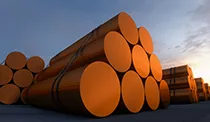We all know that stainless steel is ideal for resisting corrosion and oxidation. Stainless steel can show a perfect appearance by polishing and thus is very popular in many industries. Because of the excellent performance of stainless steel, most stainless steel is still preferred over stainless steel made into everyday items used in construction or large enterprises such as chemical and petroleum to do the structural support of equipment. So when stainless steel is exposed to moisture, will it lose its luster over time?
All metals inevitably lose their luster or rust during their use. Stain steel will inevitably lose its luster to some extent during use, but it will not generally rust. Of course, one of the reasons for this is chromium in stainless steel. It can oxidize on the surface of the metal to form a protective film to achieve anti-rust protection.
Stainless steel loses its luster because the chromium inside reacts with oxygen and produces a chromium film. When our stainless steel is used in construction, mining, medical, and other large industries, the process of losing luster is very slow. Because of the small amount of chromium in stainless steel, losing its luster is also very slow.
What type of stainless steel tends to tarnish?
The type of stainless steel we use is also important for loss of luster. There are more than 150 types of stainless steel, and the difference in the performance of different types of steel on the loss of luster is also huge. Stainless steel discoloration is mainly influenced by the minerals manganese, chromium, carbon, and iron. Products made of 316L stainless steel contain high levels of iron, chromium, nickel, manganese, and carbon. This steel may discolor more quickly than the 304L stainless steel type, which has a relatively high nickel mineral content. But because of the higher chromium content at 316L, it is more resistant to corrosion.
From the differences, you can choose the suitable steel for your environment.
Authentic stainless steel
This stainless steel has two main characteristics. First, austenitic stainless steel contains a high amount of chromium in the production process. Stainless steels made with chromium are more resistant to corrosion, stains, and loss of luster. Secondly, these items tend to be non-magnetic, although they can become magnetic through cold forming. These are the most common types of stainless steel alloys. A famous example of the use of this stainless steel is the Gateway Arch in St. Louis.
Ferritic Stainless Steel
This stainless steel is the second most common type of alloy and is also magnetic. Items produced from this alloy can be hardened by cold forming and tend to be cheaper than other types due to their lower nickel content.
Martensite stainless steel
Martensitic stainless steels are used for applications that require high tensile strength or impact resistance. In many cases, this material is also combined with a protective polymer coating to improve corrosion resistance. This material is the least common type of stainless steel alloy. And it has a high nickel content to improve the material’s formality, weldability, and ductility.
Contact with strong chlorinated substances
When exposed to chloride-rich environments (such as salt), many types of stainless steel alloys can suffer extreme pitting. For example, 304 stainless steel may begin to pit when used in naval applications due to contact with seawater (rich in salt) or salt-rich sea air. To avoid pitting, it is important to use a stainless steel grade that is particularly resistant to chlorides, such as grade 316 stainless steel. Alternatively, a special coating can be applied to the steel to prevent direct contact with chlorides in the environment.
How do you remove tarnishing on stainless steel?
To clean tarnish off stainless steel, rub the metal gently with something abrasive like steel wool or sandpaper. Stainless steel is typically hard-wearing enough to withstand abrasive materials, but if you’re worried about scratching your metal, you can easily get hold of a specialist polish and use a soft cloth to rub it in. A polish will also make the removal process quicker and easier.
If you’re looking to save money on restoring your steel, common household items that help with tarnish removal include:
- Olive oil
- Vinegar
- Baking soda
- Lemon juice
- A mixture of salt, plain flour, and white vinegar. Apply it to the tarnished metal, leave for 1-2 hours, then remove.
How do you keep stainless steel Tarnish-free?
Once you’ve restored your stainless steel to its former glory, it’s only natural to want to keep it looking bright and lustrous. One of the best ways to do this is to coat it in a clear sealant.
Applying a special sealant will add an additional layer of protection to your steel. It will prevent oxygen or other reactive molecules from reaching the surface, making tarnishing much less likely. Everbrite is a popular polish used for keeping stainless steel shiny.






















